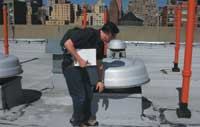The problem: A loading dock at the back of the basement was sucking cold air in at the bottom of the building and driving warmer air up. “I recommended a vestibule at a cost of $500. It solved the problem.”
Kill the watts. Most managers know that they can save money by switching from incandescent to fluorescent lights. But better fixtures can also pay off. In the hallways, for instance, he suggests more reflective ceiling fixtures. “We have 850 watts of light in a 100-foot hallway. If we can get it down to 400 watts, we will save $425 per year for that hallway. If you multiply that savings times 14 floors, it’s almost $6,000 per year.”
Watch the water. Water and hot water are among the biggest areas of waste. By code, water at the tap has to be at least 120 degrees, but it’s often much hotter. This building’s tap water measures 170 degrees–a waste. “The difference between 130 and 170 is a lot of energy and a lot of money,” Padian notes.
Of course, management has to decide whether to take his suggestions. “Management in this building pays for heat, so they’re very motivated to save,” he says. But he believes that energy savings will pay off for any building owner. Earlier this year, he audited a building in New Jersey that had a historical vacancy rate of 2 percent. Rising energy costs had jacked the vacancy rate up to 15 percent. That’s typical. “The biggest vacancies start to happen when it gets too expensive to live in a building.”
–Charles Wardell is a freelance writer in Vineyard Haven, Mass.
